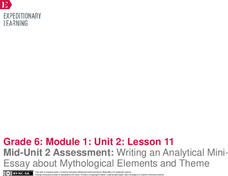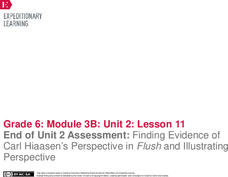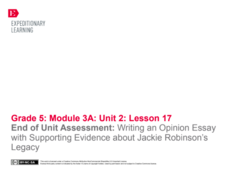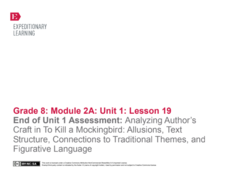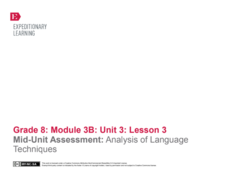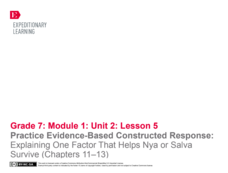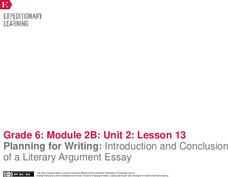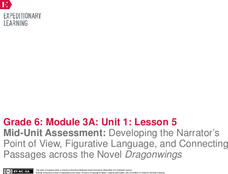EngageNY
Mid-Unit 1 Assessment: Making Inferences from Percy
Time to shine! Scholars show everything that they have learned so far in the unit by completing a mid-unit assessment. In the assessment, they discuss the gist of sections of text from The Lightning Thief and inferences they made about...
EngageNY
Mid-Unit 2 Assessment: Writing an Analytical MiniEssay about Mythological Elements and Theme
Two is company. Scholars pair up to continue their mini essay writing from the previous lesson. They work on their introduction and conclusion paragraphs and then trade partners for peer feedback and a fresh set of eyes on their work....
EngageNY
Mid-Unit Assessment: Analyzing Idea Development in Chapter 3 of World without Fish
Half way there. Scholars work on the mid unit assessment for World without Fish. Learners work independently to complete the assessment. They then answer text-dependent questions and use sticky notes for annotating.
EngageNY
End of Unit 2 Assessment: Finding Evidence of Carl Hiaasen’s Perspective in Flush and Illustrating Perspective
The end is here. Scholars work independently on End of Unit 2 Assessment: Finding Evidence of Carl Hiaasen’s Perspective in Flush and
Illustrating Perspective. Learners use their graphic organizers and text to write to a prompt asking...
EngageNY
End of Unit Assessment: On-Demand Analysis of Meg Lowman’s Research in the Rainforest
Come explore with me. Scholars complete an end of the unit assessment in which they write an essay describing how Meg Lowman explored the rainforest canopy. Pupils fill in an outline organizer before beginning their writing.
EngageNY
Mid-Unit Assessment: Analyzing Visual Elements in a Graphic Novel
Can I get a visual? Scholars work on their mid-unit assessments by analyzing vocabulary and discussing visual elements in Investigating the Scientific Method with Max
Axiom Super Scientist. They then reflect on their learning by...
EngageNY
End of Unit Assessment: Writing an Opinion Essay with Supporting Evidence about Jackie Robinson’s Legacy
Learners complete the end of unit assessment by writing an opinion essay about how Jackie Robinson changed America. They use evidence from the text, Promises to Keep, to support their opinions.
EngageNY
End of Unit 2 Assessment, Part Two: Final Draft of Analytical Essay
What's one way to make a good essay great? Revise! Scholars revise their drafts from a previous lesson plan to help write their final polished analytical essays about the universal refugee experience. They also practice properly citing...
EngageNY
End of Unit 1 Assessment: Analyzing Author’s Craft in To Kill a Mockingbird: Allusions, Text Structure, Connections to Traditional Themes, and Figurative Language
Scholars demonstrate their learning with an end-of-unit assessment. They work independently to discuss the Golden Rule and its relationship in To Kill a Mockingbird.
EngageNY
Mid Unit 2 Assessment: Text to Film and Perspective Comparison of to Kill a Mockingbird (Chapter 18 and One Scene from Chapter 19)
Have you ever heard someone say the movie is not like the book? Scholars complete a mid-unit assessment to compare scenes from the novel To Kill a Mockingbird to the movie version. The assessment contains short answers, multiple choice,...
EngageNY
End of Unit 3 Assessment: Readers Theater Commentary
Prove it! In the end-of-unit assessment, scholars write a commentary and provide evidence to justify the connection between their reader's theater scripts and To Kill A Mockingbird. After completing the assessment, they practice...
EngageNY
Mid-Unit Assessment: Analysis of Language Techniques
Show what you know. Learners demonstrate mastery of English grammar and usage by completing a pen-and-paper assessment of verbals and verb shifts. In addition, they begin composing a book review based on an independent reading book. The...
EngageNY
Preparation for Performance Task: Practicing Presentations
Practice makes progress. Working in pairs, presenters rehearse and refine their presentation skills before the big day when they pitch their film choices. Rehearsing also allows for refining prompt cards based on peer feedback and...
EngageNY
End of Unit Assessment: Presentation of Position
What is the difference between formal and informal language? Pupils rewrite their position speeches to adapt them for an audience of adults. Next, they present their speeches in small groups, attempting to answer the question, "Which...
EngageNY
Practice Evidence-Based Constructed Response: Explaining One Factor That Helps Nya or Salva Survive (Chapters 11–13)
Class members work through a model lesson plan in answering constructed response questions. They begin viewing an Evidence-Based Constructed Response sheet and then watch the teacher model. Readers then work as a group to answer a...
EngageNY
Writing an Argumentative Essay: Analyzing the Model Essay
Models and exemplars help pupils learn. Scholars read a model argumentative essay to prepare for an upcoming writing assignment. As they read, they work with partners to complete a worksheet analyzing the essay's structure.
EngageNY
Mid-Unit Assessment: Using Evidence to Support Analysis: “Frederick Douglass”
Show what you know! Scholars complete a mid-unit assessment using text evidence from Frederick Douglass. The teacher then presents expectations for independent reading assignment. Leaving the class, pupils turn in an exit ticket...
EngageNY
Analyzing a Model Position Paper: “Changing Our Water Ways”
Follow the leader for better writing! Scholars analyze a model position paper, "Changing Our Water Ways." During the first pass, they listen as the teacher reads the paper aloud. They then do a second read of the paper and complete a...
EngageNY
Mid-Unit 3 Assessment: Drafting the Position Paper
Organize your thoughts! Scholars work on the drafts of their position papers about sustainable water management. The draft serves as their mid-unit assessment. Before beginning, the class discusses the prompt and then learners work...
EngageNY
End of Unit Assessment: Final Draft of Hero’s Journey Narrative
All journeys must come to an end. Using the final lesson in the series, pupils analyze a model narrative for use of transitional words and phrases. Next, they apply their learning to their final drafts of their hero's journey narrative.
EngageNY
Planning for Writing: Introduction and Conclusion of a Literary Argument Essay
Give a powerful introduction. Scholars analyze the introductory paragraph in the model essay "Are We Medieval?: Opportunities in the Middle Ages and Today." They discuss the key components the author includes and then walk through the...
EngageNY
Mid-Unit Assessment: Developing the Narrator’s Point of View, Figurative Language, and Connecting Passages across the Novel Dragonwings
Let's get creative! As part of a mid-unit assessment, scholars create a piece of artwork illustrating the theme from Laurence Yep's novel, Dragonwings. Additionally, pupils use a graphic organizer to identify figurative language in the...
EngageNY
Mid-Unit 3 Assessment Part 2: Explaining How New Information Connects to the Topic
Take two! Scholars begin part two of the Mid-Unit 3 Assessment. They continue researching the destruction caused by the 1906
San Francisco earthquake and fires. To further their research, they discuss how new information connects to the...
EngageNY
Mid-Unit Assessment: Analyzing Point of View and Plot Development in Flush
It's the halfway point—there's no turning back now. Scholars work on the mid unit assessment for Flush. For the assessment, learners analyze the point of view and plot development by annotating the text using sticky notes and underlining...
Other popular searches
- Grading Rubrics for Poetry
- Peer Grading Rubrics
- Writing Grading Rubrics
- Presentation Grading Rubrics
- Science Grading Rubrics
- Lab Grading Rubrics
- Peer Grading Rubrics Group
- Grading Rubrics Business



